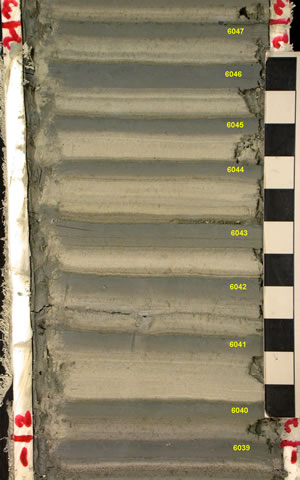Varves of the Month for 6/1/2008 - 6/30/2008
Connecticut Valley Varves at Canoe Brook, Dummerston, Vermont
This image shows glacial varves from the Connecticut Valley of southern Vermont. The winter or non-melt season layers (dark, top part of each annual layer) are labeled for New England varves 6039-6047 (lower Connecticut varve sequence, Neweeklyw England Varve Chronology numbering system of Antevs, 1922). These varves were deposited about 350-400 years after ice recession at Canoe Brook, when the receding ice margin was 40 km to the north near Charlestown, New Hampshire. Sedimentation here is still dominantly controlled by the input of sediment from the receding glacier.
Summer or melt season layers (light-colored units) are composed of a stack of micrograded units of fine sand and silt. Most of the varves have sandy and sometimes lightly oxidized layers marking the beginning (bottom) of each summer layer and a gradation of summer layers into winter layers. Gradation from summer to winter is best developed in varves 6040-6042, and 6044. The coarse layers that begin most summers are the result of rapid meltwater release from the glacier and adjacent land surface in the early summer, perhaps assisted by lake overturning. The coarse event at the beginning of NE 6044 has a clayey cap associated with it that could represent the resettling of clay disturbed by the first bottom currents crossing the lake floor as the summer begins. The summer initiating event may be instigated by the summer's first precipitation or melting event. Occasionally, as in NE 6043, 6044, and 6046 there are sand partings that are at or near the top of the summer layer and they may represent a precipitation or melting event at the end of the summer. Summer layer thickness is greater than winter layer thickness and also varies much more than winter layer thickness in these varves. In this image summer and winter layer thicknesses do not appear to vary proportionally with the two thickest summer layers (6041 and 6044) having relatively thin winter layers. Both varves 6043 and 6046 have relatively thin summer layers but relatively thick winter layers. The gray spot in the base (center) of the summer layer of varve 6042 is a carbonate concretion formed at the sandy parting in the center of the summer layer. These calcium carbonate cemented features are common in the varves of the Connecticut Valley.
Past Varves of the Month...
- 4/27/2008 - Connecticut Valley Varves from Kelsey Ferguson Brickyard, Redland Brick Co., East Windsor, Connecticut.
- 7/1/2008 - Champlain Valley varves at Keesville, NY
- 8/1/2008 - Connecticut Valley Varves at Aldrich Brook, Westmoreland, New Hampshire
- 9/1/2008 - Connecticut Valley Varves, Perry Hill Basin (PHS), Charlestown, New Hampshire
- 10/1/2008 - Connecticut Valley Varves, Perry Hill Basin (PHN), Charlestown, New Hampshire.
- 11/1/2008 - Connecticut Valley Varves, Aldrich Brook site, Westmoreland, New Hampshire
- 12/1/2008 - Connecticut Valley Varves, Aldrich Brook site, Westmoreland, New Hampshire
- 1/1/2009 - Mine fire reclamation site, Olyphant, Pennsylvania
- 2/1/2009 - Connecticut Valley Varves, Perry Hill Basin (PHS), Charlestown, New Hampshire
- 3/1/2009 - Connecticut Valley Varves, Perry Hill Basin, Charlestown, New Hampshire
- 4/1/2009 - Connecticut Valley Varves, Perry Hill Basin, Charlestown, New Hampshire.
- 5/1/2009 - Connecticut Valley Varves, Perry Hill Basin, Charlestown, New Hampshire
- 6/1/2009 - Connecticut Valley Varves, Perry Hill Basin, Charlestown, New Hampshire
- 7/1/2009 - Connecticut Valley Varves, Perry Hill Basin, Charlestown, New Hampshire
- 8/1/2009 - Connecticut Valley Varves, Perry Hill Basin, Charlestown, New Hampshire
- 9/1/2009 - Connecticut Valley Varves, Perry Hill Basin, Charlestown, New Hampshire
- 10/1/2009 - Connecticut Valley Varves, Perry Hill Basin, Charlestown, New Hampshire
- 11/1/2009 - Connecticut Valley Varves, Perry Hill Basin, Charlestown, New Hampshire.
- 12/1/2009 - Connecticut Valley Varves, Perry Hill Basin, Charlestown, New Hampshire
- 1/1/2010 - Connecticut Valley Varves, Perry Hill Basin, Charlestown, New Hampshire
- 2/1/2010 - Varves along Starrucca Creek near Lanesboro, Pennsylvania
- 3/1/2010 - Varves in the Don Valley, Toronto
- 4/1/2010 - Varves along Sandy Stream, Dennistown Plantation near Jackman, Maine
- 5/3/2010 - Varves from Glacial Lake Great Falls in Montana
- 6/4/2010 - Varves from Charlestown, NH
- 7/1/2010 - Varves from Redlands Brick Co. (Kelsey Ferguson Brickyard, South Windsor, Connecticut) - A varve that Antevs missed
- 8/1/2010 - Varves from Glastonbury, Connecticut
- 9/1/2010 - Varves from North Hatfield, Massachusetts
- 10/1/2010 - Varves from Newbury, Vermont
- 11/1/2010 - Varves from Newbury, Vermont
- 12/1/2010 - Varves from Newbury, Vermont
- 2/1/2011 - Connecticut Valley Varves at North Hatfield, Massachusetts
- 3/1/2011 - Connecticut Valley Varves Kelsey Ferguson (Redlands Brick Co.), South Windsor, Connecticut
- 6/1/2011 - Connecticut Valley Varves: Core at Scantic, East Windsor, Connecticut
- 8/1/2011 - Varves of West Canada Creek Valley, western Mohawk Valley
- 10/1/2011 - Varves of West Canada Creek Valley, western Mohawk Valley collected in Newport, NY
- 12/1/2011 - Connecticut Valley Varves at Claremont Junction, NH
- 3/1/2012 - Connecticut Valley Varves at Westmoreland, NH
- 7/1/2012 - Connecticut Valley Varves at Rt. 12A drill site in North Charlestown, N.H.



